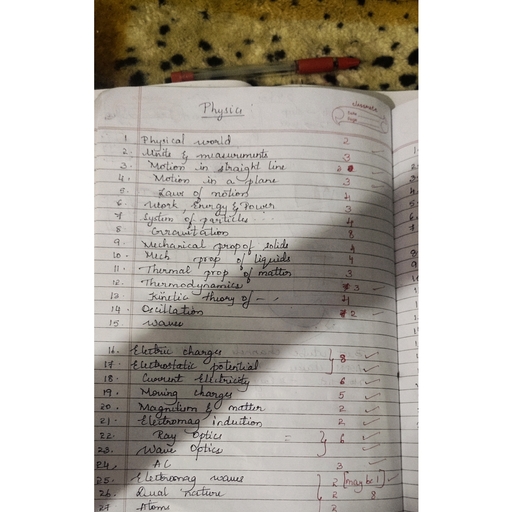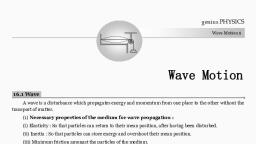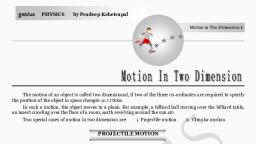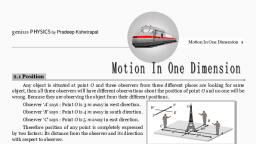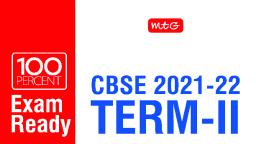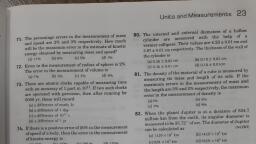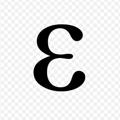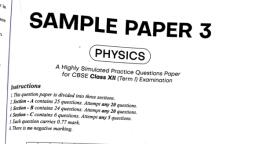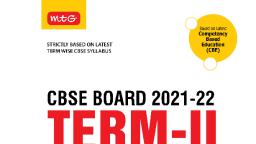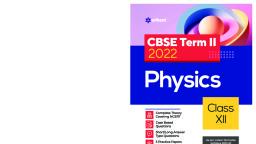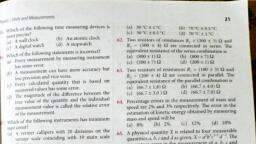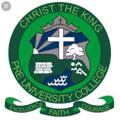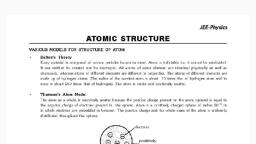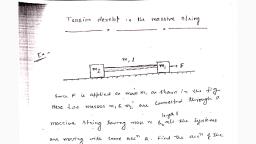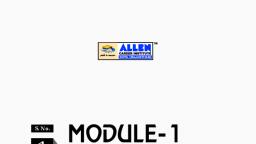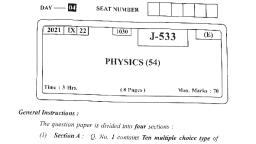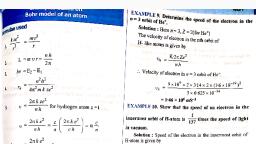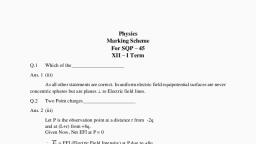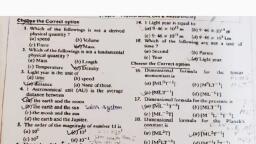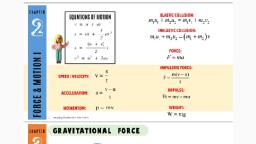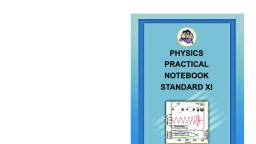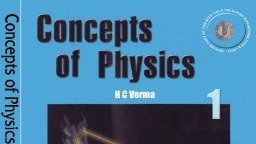Page 1 :
Problems:, , ELECTRIC CHARGES AND FIELDS, , insulated charged copper sphere A and B have their centers separated by a distance of, 50cm. What is the mutual force of electrostatic repulsion if the charge on each is 6.5x, 10-C. The radius of A and B are negligible compared to the distance of separation., , 1) Two, , r= 50 cm, , Given:, , 50 x 1072 m, = 6.5 x 10-2, , 9192, , =, , c, , F =?, , l4192, 4TTE r2, For q1 and q2 only magnitude is considered., 1, , F, , x 6.5 x 10-2, (50 x 10-2)2, 9x 6.5 X 6.5, 380.25, x 10-1 =, x 10, F=2500, 50x 50, , 10, x 6.5x, , =, , 0.01521 N, , l, , 0.1521 x 101, , The electric force on a 0.4uC charge due to another charge -0.8pC in air is 0.2N. Find the, distance between the charges and the force between them when they are brought in to, contact and then replaced in their initial positions., 0.4 x 10-6 C, uC = 0.8 x 106 C, , 41=0.4uC =, , Given:, , 1=0.8, , 0.2 NN, , F, , P, , 2), , =, , ati, , F = 9 x 10, , r=? and F' =?, 1, , R, , F4T&€o 9192, r2, , 9192, , 1, , 4TE0, , 0.4 x 106 x 0.8 x 10-6 9 x 0.4 x 0.8x, 10-3 =9x, 0.2, 0.2, x2 x 10-2 = 12> l0 m == 12 cm, , x-, , 9 x 10, , =, , K, , r, , F, , T = 3, , x, , 2, , 4x4x, , 10-4, , When two bodies are kept in contact, the flow of charges takes place and this continues till, equilibrium exists., Net charge = (+0.4 x 10-6) +(-0.8 x 10-) = -0.4 x 1076 C, Charge on each body = (4X 10 72)= 0.2 x 106 C (only magnitude is considered), 1, , F', , F', , 9192, , 4TtE0, , =, , r2, , 9x 10°, , 9x0.2, , 10-6 x 0.2 x 10-6, x 0.2 x (12, x 10-2)2, , x 0.2, , 12 x 12, 3), , x 101 =.0.36., , 144, , 10= 0.025 N, , A conducting sphere of radius 10cm has an unknown charge. If the electric field, 20cm, from the centre of the sphere is 1.5 x 103 NC-1 and points radially inward, what is the net, , charge on the sphere?, Given:, , radius = 12 cm = 12x 102 m, r = 20 cm = 20 x 104 mn, , KUBERAGOWDA R P MSc,BEd. Lecturer in physics Akshara Pu college shikaripura
Page 2 :
=, , E, , NC-, , 1.5 x 103, , q =?, , E, , 1, , =44TE r2, 1.5 x 103 x (20 x 10-2)2, , Er, , 1.5x 20 x 20, , 9x 10°, , X, , 10, , 10, , 66.66 x 10-10 = 6.666 x 10- C = 6.666 n C, Charge is negative (Given electric field is radially outwards), q, , 4) An electric dipole with dipole, of a uniform electric field of, , moment 4 x 10-C- m. is aligned at 30 with the direction, magnitude 5x 10*NC1 Calculate the magnitude of torque, , acting on the dipole., p =4, , Given:, , X, , 107, , C- m, , = 5, , T, , =?, , x 10t NC-1, , ati, , E, , l, , 6 = 300, , TpEsin 6, 4 x 10x, , 5x 10t x sin 30, , 4 x 5 x 10-5 x 0.5, , =, , 10 x 10-5, , =, , 10* Nm, , P, , T=, , charges qa = 3pC and qp =-34C are located 20cm apart in vacuum. What is the, electric field at the mid-point 0 of the line AB joining two charges? If a negative test charge, of magnitude 1.5 x 10-9C is placed at this point, what is the force experienced by the test, charge. (Mar 2017), , R, , 5) Two point, , A3u C = 3 x 10-6 C, 10-6 C, B-3 uC = -3 xcm, , Given:, , K, , Distance (2a) = 20, a = 10 x 104 m, , Test charge, q, F=?, , = 1.5, , =, , x 10-, , A, , Radially Outwards, , 1, , 4TtE, EA =, , Ep =, , E,, Fo, , 6), , =, , Eg, , Radially Inwards, , 20x 1074 m, C, , Electric field at O is Eo which is given by, E,, , EA, , EA, , =, , Ea, , +Ep and direction is along AB., , a, , x3x 103, = 27 x 105 NC-1 Along AB, 10-2, EA = 27 x 103 NC-1 Along AB (Since qa = 4B), 27 x 105 +27 x 105 = 54 x 105 N C-l Along AB., , 9x 10", , 3, , x, , 106, , x x 10-2)2, (10, , qEo = 1.5 x, , 10x, , 9, , 54 x 105, , =, , 81 x 10-4 N, , Two point charges 1nC and 4nC are separated by a distance of 0. 1m in air. Calculate the, point at which the resultant electric intensity is zero., , [Hint: For a system of two like charges, the null point lies on the line joining the charges, in, between the two charges and is closer to smaller of the two charges. For a system of two, unlike charges, the null point lies on the line joining the charges, but outside the two charges, of the two charges.], and is closer to the smaller, KUBERAGOWDA, R P MSc,BEd. Lecturer in physics Akshara Pu college shikaripura
Page 3 :
= 1x, , A1nC, , Given:, , 4n C =, , B=, , 10- C, 10-°, , 4 x, , Distance (2a), , E, , C, , 0.1m, , =, , E2, , E= 0, , (0.1-x), , 91, , A some point between two point charges E will become zero., Let P be that point which is at a distance x from q1 and (0.1 x) from, AtP, E1- E2 = 0 (E = + ve and E2 = - ve due to direction), -, , -x)2*, , 47tEx2, , 4TE (0.1, , Tex, 91, , (0.1-x))O, 4 x 10-9, , 2, , 0.033 m E, , =, , =, , 0.1- x =, , =, , 0, , 2x, , 0.1-x, , 3x, , =, , 0.1, , x, , l, , 0, , (0.1- x)2, , 0.033 m, , =, , ati, , 1x 10-9, , +0, , since, , (0.1- x), , At, x, , q2, , 1, , 1 1, , x2, , 92, , equilateral triangle of side 0.1 m. Point charges of +3 nC and -3 nC are placed at, corners of A and B respectively. Calculate the resultant electric field at C., , Given:, , B=-3, =, , Outwards, 0.1 m, , R, , a =?, , Electric field at C is Ec given by, Ec, , 1, , radially, , 0.1 m, , E =? and, , EA, , 1A, , 10- C, nC = -3 x 10-9 C, = 3 x, , 43nC, r, , P, , 7) ABC is an, , A, , = Ea, , +, , EB, , radially, , inwards, , 1200, EA, , K, , 47TE0r, , 9x, , =, , EA, , Eg, , 10-9, , 10 x3x(0.1)2, , EA =, , 27, , 2.7 x 103 NC*1 Along CB, , Magnitude of electric field, E, E =, , E, , +ER, , E, , E, , +E +26, , =, , x 103 NC-1 Along AC, , 0.012.7, , =, , +26E cos0, cos 120", , E = 2.7 x 103 NC 1, As Ea = Eg, the direction of E is, , VE +Eß, (Since, , |2-2E,, , + 2EEp cos, EB), , EA =, , x= |2E -E= E=EA, , along the bisector of the angle C., , or, Eg sin 0, , tan a=-BA +Eg, tan a, a, , =, , ,, , cos 6, , E sin6, EAC1, , + cos 0), , tan(1.732), , =, , 1, , sin6, + cos, , sin 120, 1+ cos 120, , 0.8660, 0.5, , 1.732, , 59.999 60°, KUBERAGOWDA R P MSc,BEd. Lecturer in physics Akshara Pu college shikaripura
Page 4 :
Charges of +10tC, +20C and -20C are placed in air at the corners of an equilateral, triangle having each of side equal to 0. 02m. Determine the force on charge +10uC., , 10 uC =, 4B= 20 uC =, , Given:, , qA=, , 10 x 10-6 C, , 20 x 10-6 C, Gc=-20u C = -20 x 10, r = 0.02 m, F =? (on qA), , 0.021m, C, , C, , Electric field at A is given by, E = Ep + Ec, 1 98, Ep, 4TTEr2, 20 x 106, x 10-6, x 10x., 109 x 20, =9x, EB=9, (0.02)2, 4x 10-4, AC, 10", Ep, x, Ec, NC-1 Along, 45, , =, , 45 x 10' NC-1 Along BA, , Magnitude of electric field, E^ =E+E+2EpEc, , E, , =, , E, , +2EgEg cos, , +E +25, , (Since Ep, , =, , cos6, Ec), , ati, , F+ Eß, , EA, , C, , 120, , l, , 8), , cos 1200, , 2E-2Ex= 25-E E, , =, , Es, , is given by, F, , =, , qaEA = 10, , x 10- x 45 x 10, , =, , 45 x 10 N, , =, , 4500 N, , Three charge each equal to +4 nC are placed at the three corners of a square of side 2 cm., Find the electric field at the forth corner. (Mar 2018), , Given:, , A 9B, Side,l, , = qc =, , = 2, , K, , 9), , qA, , R, , Force on, , P, , 45 x 107 NC -1, As Ep = Ec, the direction of Ea is along the bisector of the angle A., EA =, , =, , cm, , x 104 m, BD= V2 x 2x 10-2 m =, , AD = CD, , 4n C, , = 2, , =, , 4 x, , 10-, , C, , x 104 m, , 2, , 2, , 22x 10 2 m, , x 102, , EA, , Ec, , 1A, , EA, , 4TE AD2, , EA9X 10, , 4x 10-9, (2 x 10-2)2, , Ec =, , 10%, , EA =, , 9x, , 9 x4, , X104, 4, , N C-1 Along, , =, , 9x, , 10t NC- Along AD, , CCD, , 1, , EB4TtEgBA, , E, , =, , 9x 10, , EACE, E, , Ep, , 4 x 10-9, , +E, , t Eac, , 9x4, , x-(2 2 x 10-2)2 4 x 2*, , =, , =, , E, , +F, , =, , 26, , 4.5, , = VZ, , 4.5 x 10t +12.72 x 10, , =, , E, , =, , X, , 10* NC-1 Along BD, , 1.414 x 9x 10*, , =, , 12.72 x 10* Along BD, , 17.22 x 10* NC-1 Along BD, , KUBERAGOWDA R P MSc,BEd. Lecturer in physics Akshara Pu college shikaripura
Page 5 :
10) A spherical conductor of radius 12 cm has a charge of 1.6 x 10-7 C distributed uniformly, on its surface. What is the electric field (a) Inside the sphere (b) just outside the sphere and, (c) at a point 18 cm from the Centre of the sphere?, , Given:, , 12 cm, , radius, , =, , 1.6, , x 10-7 C, , =, , 12 x 104m, , (a) E = 0, Inside the conductor., , (b) Just outside the conductor r=12, , x 10, , m, , 1, , EATtEo, , 2, , (c) Whenr, , =, , =, , 14.4, 144, , x, , 144, 10 = 105NC-1, 10°144x, 44, , 18 x 10-2 m, , =, , l, , E, , 18 cm, , 10°, , 107, , 1.6 x, , x(18x, , 9x 10, , 10-2)2, , 9x 1.6, , ati, , =. r, 4tE, , 9x 1.6, , (12 x 10-2)2 12 x 12, , =, , E, , 1.6 x 10-7, , x-, , E = 9x 10, , 14.4, , 105; 29X 10°, 18 x 18*, 324, , =, , 0.0444, , =, , 4.44 x 10-2 N C-1, , support. When, charged identically, the two pith balls move apart by 0.08 m, the threads making angle 60, with each other. Calculate the charge on each ball., = 30, , mg, , = 30 X 10**, , x 103 kg, , A, , R, , mass, m, , Given:, , P, , 11) Two pith balls each of mass 30 mg are suspended by two threads from a, , Use Lemi's theorem., "The ratio of each force to the sine of the angle, between the other two is a constant", sin 90, , Sin 150, , F, , T, , F, , 90, , sin 120, 0.08m-, , W, , sin 30, , sin90, , 120, , Jan-*************, , 150, , K, , F, , 60, , B, , W, , T, , 0, , sin 60, , W, , V3, , 2, , 2F=, , T, , F, , W, , =, , V3, , mg, , F, , 2W, , 30 x, , 103 x 10-3 x 9.8, V3, , =, , 1.69 x, , 10*, , N, , Let q be the charge on each ball., 1, lql, F, , 4TtEo T2, =, , q, , =, , Fr, , 1.69 x 10 x (0.08)2, = 0.0012017 x 10-13, 9x 10°, , =, , 0.012017 x 10-14, , x 10-°C = 10.96 MSc,BEd. Lecturer in physics Akshara Pu college shikaripura, 0.1096 x 10-7 = 10.96, KUBERAGOWDA R PnC
Page 6 :
Problems for exercise., 1) Two point charges q4, , =-5uC are located At A and, , separated by 0.2 m apart, in vacuum. What is the electric field at the mid-point 0 of the line joining two charges? If a, negative test charge of magnitude 2 nC is placed at this point, what is the force experienced by, the test charge. (Mar 2020), 2) Find the point on the line joining the two charges +12nC and +3nC where the resultant field, is zero. Distance between the charges is 1.2m., 3) Two charges 9nC and -16nC are placed 8m apart in vacuum. Find the position of a point of, zero fields along the line joining them., 4) Two point charges 4x 10-8C and 6 x 10-8C are placed at the vertices A and B of an, equilateral triangle ABC of side 0.1m. Calculate the electric field at the vertex C for the, =, , 5pC and qp, , B, , K, , R, , P, , ati, , l, , triangle., , KUBERAGOWDA R P MSc,BEd. Lecturer in physics Akshara Pu college shikaripura
Page 7 :
Problems:, , ELECTROSTATIC POTENTIAL AND CAPACITANCE, , 1) Two charges 3 x 10-8C, , and -2 x 10-8C are located 15cm apart. At what point(s) on, the line joining the two charges is the electric potential zero? Take the potential at, infinity to be zero. (Jul 2014), , A3 x 10-8c, B=-2 x 10-8c, , Given:, , 2a, , d, , =, , =, , 15 cm= 15 x, , 10 m, , i) Let P be a point of zero potential, anywhere in between A and B, which, is at a distance x from q», , Fo, , 1, , (d-, , A, , 9B=0, , since, , x, , x, , 108, , 2 x, , -x), , (15 x 10-2, 3 x 10-8, , (15x 102, 3, , 1, , 0), , ATTEO, , 108, , 2x 10-8, , -x), , x, (15x 10-2 - x), 3x 30 x 102- 2x, 30 x 10-2 5x, 3x+2x, x = 6 X 104 m = 6 cm, , 30 x10-2, , K, , =, , i) Let P' be a point of zero, potential anywhere outside A and, B, which is at a distance x from qp, , A, (d +x), 3, , +Vg, , =0), , 4TE0 *, , 4B= 0, , (d-x)-, , l, , (Vp, , 9A, , (d-x), 3, , 0, , = Va, , 10 m-, , R, , 1, , =, , is given by, Vp, , 15 x, , P, , +V, , VA, , Vp, , =, , ati, , Potential at P is, , -d, , =0, , x 10-8, , (15 x 10-2+ x), 3x 10-8, , (sirnc, 10-8, , 2x, T, , 2 x, , A-, , =, , 15 x 10, , m-, , QA, , 0), , 4TtEo, , 0, , 10-8, , (15 x 10-2 +x), 3, , 2, , (15x 10-2 +x)*, 3x = 30 x 10-2 + 2x, 3x 2x = 30 x 10Z, x = 30 cm, , x= 30 x 1072 m, , KUBERAGOWDA R P MSc,BEd. Lecturer in physics Akshara Pu college shikaripura
Page 9 :
9A+9s, , t Ac+9p =0, +, , 9p-(4A, 4), , since, , +4c), , 4p, , =, , 4tEo, , xvN2, , -(24uC + 44C + 6uC), , =-12 uC, , In parallel plate capacitor with air between the plates, each plate has an area of, 6x 10 m and the distance between the plates is 3mm. Calculate the capacitance of, the capacitor. If this capacitor is connected to a 100V supply, what is the charge on each, plate of the capacitor? (Absolute permittivity of free space=8. 85 x 10-12Fm-1) (Mar, 2014), A = 6, , Given:, , d, , = 3, , x 10m, mm = 3 x 10- m, , 100, , V =, , V, , Eo8.85 x, , 10-12, , Fm-1, , Q, , CV, , =, , ati, , 8.85 x 10-12 x 6 x 10-3, 8.85x, 3 x 10-3, , 2, , x 10-12, , =, , P, , =, , l, , c17.70 x 10-12 x 100, , 17.70 x 10-10, , =, , 17.70 x 10-12 F, , C =, , 1.77 n C, , on each, , R, , 5) Three capacitors of capacitance 2pF, 3pF and 4p¥ are connected in parallel., (a) What is the total capacitance of the combination? (b) Determine the charge, , capacitor, if the combination is connected to a 100V supply., Given:, , C = 2pF, , pF, C3=4pF, , K, , C23, V, , =, , 2 x 10-12 F, , = 3 x, = 4, , 1012 F, , x 10-12 F, , 100V, , (a) For parallel combination, C =, , C, , 2x 10-12 +3 x 10-12, , C1, , + C2 + C3, , + 4 x 10-12, , =, , 9x 10-12 F = 9pF, , (b)C, CV and for parallel combination V = V2 = V3 = V, (i) Q1 = C1V = 2x 1012 x 100 = 2x 10-10 = 0.2 nC, (i) Q2 = CV = 3 x 10-12 x 100 =3 x 10-10 = 0.3 n C, , Q =, , (ii), 6), , Qg = CaV =, , 4 x 10-12 x 100, , =, , 4x 10-10, , =, , 0.4n C, , The plates of a parallel plate capacitor have an area of 100 cm each and are separated, by 3 mm. The capacitor is charged by connecting it to a 400 V supply., (a) Calculate the electrostatic energy stored in the capacitor., (b) If a dielectric of dielectric constant 2.5 is introduced between the plates of the, capacitor, then find the electrostatic energy stored and also change in the energy, ored. (ul 2018), KUBERAGOWDA R P MSc,BEd. Lecturer in physics Akshara Pu college shikaripura
Page 10 :
Given:, , A = 100, , 3, , d, V =, , cm, , mm, , 100 cm, , =, , xX cm =, , 10 x, , 10, , m x 10, , mn =, , 10m, , 3x 10-3m, , =, , 400V, , K, , 2.5, , C, , first., , (a), , E-cv2, Calculate, EpA, C=, , d, 8.85 x 10-12 x 10-2, , C, , E, , 8.85, , =x 2.95x, , 10-1l, , X, , 3x 10-3, , =, , 2.95 x 10-11 f, , x 400 x 400 236000x 10-11j, , 10-11, , =, , 2.36 x 106, , K times,, , where K is called dielectric constant., , ati, , by, , C' = CK, , 2.5x 2.36 x 10-6, , E', , Change in energy, AE, , =, , = KE, , 5.9x 10-6 J, , E', , -, , E, , =, , 5.9 x 1076 2.36, , x 106, , =, , 3.54x, , 10-6, , Given:, , R, , Two capacitors of 3pF and 5pF are connected in series. Calculate the equivalent, capacitance. If a battery of emf 10V is connected across them, Calculate, (a) the charge, on each capacitor and (b) the potential difference across each other., uF, =5uF, , C1 =, , C2, , 3, , = 3, , V =, , 10, , x, , 5x, , =, , K, , 7), , =, , Kx5cv, , =, , P, , E'=cv =;(CKV?, , l, , (b) If a dielectric is introduced between the plates of a capacitor, the capacitance increases, , 106, , F, , 10-6F, , V, , For series connection,, , C, , C, , CC, , 10- x 5 x 10-6, 3x 10-6+5 x 10-6, 3 x, , CC+C2, C =, , 15x 10-6 x 10-6, 8x 10-6, , 15, , x, 8, , 106, , =, , 1.875 x 10-6, , 1.875 p F, , (a) For series combination, Q1 = Q2 =, , Q, , C=, Q = CV =, , 1.875x 10-x, , 10, , =, , 18.75 x 10-6, , C, , (b), , V, , 18.75 x 10-6, , 3x 10-66.25, 10-6, 18.75, = 3.75, 10, , 1, , V, , C, , x, , 5x, , V, VV, , KUBERAGOWDA R P MSc,BEd. Lecturer in physics Akshara Pu college shikaripura
Page 11 :
30uF and 40pF are charged to 100V and 80V respectively. If they are, connected in parallel, calculate the energy stored and loss of energy due to connection., , 8) Two capacitors of, , C, , Given:, , =, , C2, , F, , =, , 30 x 10-6 F, , 40 F, , =, , 40 x 10-6 F, , 30, , V, , =, , 100V, , V2, , =, , 80, , V, , E=5C +Cz)V2, is called common potential difference, when they are connected in parallel, 1_CGV + C2V230 x 1076 x 100 + 40 x 10-6 x 80 3000 x 10-6+ 3200x 10-6, C1 +C2, 70 x 10-6, 30x 10-6 + 40 x 10-6, , where, , V, , x, , 0.2745, , =, , AE, , 30 xx 10-6 + 40 x 10-6 x, AE5X30 10-6+ 40x10-6, AE, , 3400 x, , 106, , =, , 1, , (80-100)*, , =z*-1200 x 10-6 x, , 10-6, , 70 x 10-6, , x 202, , 0.0034, , The effective capacitance of two capacitors is 7 u F when in parallel and, , u F when in, , R, , 9), , =, , =x 70 x 10-6 x 7844.64, , P, , 1, , 2, , ati, , (30 x 10-6 + 40 x 10-6) x (88.57), , 274562.57 x 10-6, , E, , V, , 88.57, , l, , 6200x 106, 70 x 10-6, , V =, , series. Find the individual capacitance., Cp= 7 uF, , Given:, , K, , Cs=u, , =, , 7x 1076 F, , =;x 106 F, , ForParallel combination,, C +C2, , =, , 7x 106, , ---, , Cp =, , CG, , +C2, , -(1), , For Series combination,, , CC2, , CsC, CC2, , = (C1, , CC2, , =, , 6, , +C2)Cs, , +C2, , =, , 7x 1076 x, , x 10-6, 6, , x 10-12 ----(2), , We have, (C -C2) = (C1 + C2)- 4 CC2, 10-12 = 49 x 1012, (C-Ca)2= (7 x 10-6)2 -4x6x, (C-C2) = 25 x 10-12, -(3), C1-C2 = 5 x10-6--, , -, , 24 x 1012, , Solving equations (1) and (3), C1, , +, , C2 =, , 7x 10-6, , C-C2=5 x 10-6, 2C1 = 12, , x 10-6, , KUBERAGOWDA R P MSc,BEd. Lecturer in physics Akshara Pu college shikaripura
Page 12 :
10-6, Substituting for C in equation (1), C + C2 = 7x 1076, x 106 =1x 10-6, C2=7X 10-6 C = 7x 10-6, C =6 x 106 F and C2 = 7 x 10-6 F, X, , 16, , -6, , 10) A capacitor of capacitance, , 5uF is charged to potential of 500V. Then it is disconnected, from the battery and connected to uncharged capacitor of capacitance 3pF. Calculate, the common potential, charge on each capacitor and the loss of energy., = 5, , C, , Given:, , uF, , x, , = 5, =, , C2= 3 uF, , 106, , F, , x 10-6 F, , 3, , = 500bV, , V, , 0 V, , V2 =, , l, , When two capacitors (one charged and another uncharged) are connected, there is, redistribution of charges and each capacitor acquires same potential called common, , potential (V)., -, , x, , C1+C2, , 1076, , 10- +3 x 10-6, , CV= 5 x 10-6 x 312.5, , =, , Q2, , C2V = 3, , x 106 x 312.5, , =, , 8 x, , 1, +3 x 106 (500-~0)2=x, x 10-6 43x 10-6), , R, , 15 x 10-6, , AE=x, , 312.5, , VV, , 1562.5 x 106 F, 937.5 x 10-6 F, , 10-6, , 5x, , AEz, , 10-6, , =, , P, , Q1, , x02500 x1076, , ati, , +, 10-6 x 500 + 3 x, =_CVi CaV25x 5, , 23.43 x 10-2, , x 250000, , =, , 0.2343, , K, , 8, , 15x 10-6 x 10-6, x 5004, 8 x 10-6, , 11) When two capacitors are connected in series and connected across 4kV line, the energy, stored in the system is 8 J. The same capacitors, if connected in parallel across the same, , line, the energy stored is 36 J. Find the individual capacitances. (Mar 2016), , Given:, , V =, , 4 kV, , Us =, , 8, , Up =, , = 4, , x 103, , V, , 36], , For parallel combination,, Vv2, , Up, , Cp, , Up, , C +C2)V2, , x, 1, , 36, , (C + Ca) x (4 x 10 )2, , 36x2 36x2, C+ C2 (4 x 103)2 16 x 106, , = 4.5, , x 10-0, , -, , --(1), , For series combination,, , Us, , CsV, , KUBERAGOWDA R P MSc,BEd. Lecturer in physics Akshara Pu college shikaripura
Page 13 :
U-, , x, , 8-, , 10, , x(4x, , CC2, , 8 x 2, , 16, 16 x 105, , C +C2 4 x 103)2, CC2 = (C +C2) x 10-6, , We have, (C-C2), (C -C2)2, (C C2), , C-C2, , =, , =, , =, , 10, , 4.5 x 106 x 10-e, , (C + C2), , -, , (4.5 x 106)2, = 2.25 x 10-12, 1.5 x 10-6 ---(3), =, , =, , =, , 4.5 x, , -4 C1C2, , 4x 4.5 x 10-12 =20.25, , 10-12----(2), , x 10-12, , 18 x 10-12, , Solving equations (1) and (3), , 2C1 = 6.0, , C, , =, , l, , C1-C2, , 4.5 x 10-6, = 1.5x 10-6, , =, , x 1076, , 3x 10-6, , Substituting for C in equation, =, , 3x 10-6 F and, , =, , 4.5 x, , C2 =, , +C2 = 4.5 x 1010-6 = 1.5 x 10-6, , 106 -3x, , 1.5 x 10-6 F, , R, , C, , C, , CG, , P, , 4.5x 10-6, , C2, , (1),, , ati, , C +C2, , K, , Problems for exercise:, 1) Two point charges +1nC and -4nC are 1m apart in air. Find the positions along the line, joining the two charges at which resultant potential is zero. (Mar 2015), 2) Two charges 5 x 10- C and -3 x 108 C are located 16cm apart in air. At what point(s), on the line joining the two charges is the total electric potential zero? Take the potential at, infinity to be zero., 3) Two point charges 5 x 10-8 Cand-3 x 10-8 C are located 16cm apart. At what points on, the line joining the two charges is the electric potential zero?, 4) Three point charges of 4nC, 5nC and -8nC are placed at the corners A, B and C of a, square ABCD of side 0.1m. Find the amount of work required to move a charge of 2nC, from D to the centre of the square., 5) ABCD is a square of side 1m. Point charges of +3nC, -5nC and +3nC are placed at cornerS, A,B, C respectively. Calculate the work done in transferring a charge of 12 C from D to, the centre of the square. [June 2019], 6) In a circular parallel plate capacitor radius of each plate is 5 cm and they are separated by, a distance of 2 mm. Calculate the capacitance and the energy stored, when it is chargedd, by connecting the battery of 200 V ( given so 8.854x1012 Fm) (Mar 2019), 7) You are provided 3 capacitors, each of capacitance12pF. In how many ways they can be, combined. Calculate the effective capacitance in each case., 8) Three charges 64uC, 4uC and 24C are placed at the corners of a square ABCD respectively, of side 1m. Find the value of charge placed at the 4th corner to get total potential zero at, the centre of the square., , KUBERAGOWDA R P MSc,BEd. Lecturer in physics Akshara Pu college shikaripura
Page 14 :
11), , 12), 13), , 14), , A and B are the two points at 0.03m and, , 0.09m from the point O, find the potentials at A and B. Also find work done to move a, point charge of 1.6 X 10-1C from B to A., In parallel plate capacitor with air between the plates, each plate has an area of, 8x 10 m and the distance between the plates is 2 mm. Calculate the capacitance of the, capacitor. If this capacitor is connected to a 50 V supply, what is the charge on each plate, of the capacitor? (Absolute permittivity of free space=8.85 x 10-12Fml) Jul 2017), A 600 pF capacitor is charged by a 200 V supply. Calculate the electrostatic energy stored, in it. It is then disconnected from the supply and is connected in parallel to another, uncharged 600pF capacitor. What is the energy stored in the combination?, A 400 pF capacitor charged by a 100 Vdc supply is disconnected from the supply and, connected to another uncharged 400pF capacitor calculate the loss of energy., A 0.6uF capacitor is charged by a 200V supply is connected to another 0.8uF capacitor, charged by 100V supply. Find their common potential. How much electrostatic energy is, lost in the form of heat and electromagnetic radiation?, A 600 pF capacitor is charged by a 200 V supply. It is then disconnected from the supply, and is connected in parallel to another uncharged 600pF capacitor. How much, electrostatic energy is lost in this process?, A 4 x 106F capacitor is charged by a 200V supply. It is then disconnected from the, supply and is connected across another uncharged 2 x 10-6F capacitor. How much, energy of the first capacitor is lost?, , K, , R, , P, , 15), , IE, , l, , 10), , A point charge of 10tC is situated at a point O., , ati, , 9), , KUBERAGOWDA R P MSc,BEd. Lecturer in physics Akshara Pu college shikaripura
Page 15 :
Problemns:, , CURRENT ELECTRIITY, , the current density and average drift speed of conduction electrons in a copper, wire of cross sectional area 1.0x 10-7 m carrying a current of 1.5 A. Given free electron, density of copper is 8x 1028 electrons/m*, e = 1.6x 10-19 C., , 1) Calculate, , Given:, , 1.0 x, , A, , I, , 10-7 m2, , 1.5 A, n = 8 x 103 electrons/m*, e = 1.6 x 10-19 C, =, , 1.5, 1.0, , I, , =, , x 10-7, , 1.5, , x 107 Am2, , neAVd, 1.5, , Va =, , 1.6 x 10-19x 1.0 x 10-7, , 8x 1.6 x 102, , =, , 0.117 x 10-2, , ati, , 8 x 1028 x, 1.17x 1073 ms*, , neA, , l, , 1.5, Va, , number density of free electrons in a copper conductor is 8.5 x 1028 m3. How long, does an electron take to drift from one end of a wire 3.0 m long to its other end? The area of, cross section of the wire is 2.0 x 10-o m and it is carrying a current of 3.0A., , Given:, , n, , 8.5 x 1028 m-3, , =, , 3m, , l=, , 2.0 x 10-0 m2, , I=, , =, , neAva, , R, , A =, , I, , P, , 2) The, , 3A, , 3, , 3, , Vd neA, , K, , 8.5x 1028 x 1.6 x 10-19 x 2.0 x 10-7, , 27.2 x, , 103.Il029 X 10ms-1, , Time taken to drift 3 m long can be calculated as,, Distance travelled, velocity =, time taken, Vd, , 3, , t, , 0.11029x 10-3, , =, , 27.20 x 10 second, , of 2. 10 at 27.5°C and a resistance of 2.7, the temperature co-efficient of silver. Also find its resistance at 0°C., , 3) A silver wire has a resistance, , Given:, , 2.1, 2.7, , Ro, R, , To =, , T, , at 100°, , C., , Find, , 27.50, 1000, , Ro, , R, , RoCT-To), , 2.7-2.1, , 2.10100, , 0.6, , =, , 0.00394088 0 C-1, , 27.5) KUBERAGOWDA, 2.1x 72.5, R P MSc,BEd. Lecturer in physics Akshara Pu college shikaripura
Page 16 :
If we take R = 2.1 2 and T = 27.5", the resistance at zero degree (To = 0°) is taken as Ro, R = Ro[1 + a(T To), R, 2.1, 2.1, 2.1, N, R1+a(T-To)1+0.00394(27.5, 0)1+0.1084 1.1084 1.89, -, , 4), , 100 mg mass of nichrome metal is drawn in to a wire of area of cross-section 0. 05 mm'., Calculate the resistance of the wire. Given density of nichrome 8.4 x 10* kg ms and, resistivity of the material as 1.2 x 10-6 Q m. (Mar 2018), , m, , Given:, , =, , 100 mg, , 0.05 mm', , A =, , =, , Density, D, , P=1.2, mass, , X, , 100 x 10-3 x 10-3 kg, , =, , =, , 0.05 mm x mm, , =, , 8.4 x, , 5.72, , 103 x 0.05 x 10-6, , 0.05 x 10-6, , Qn, , Three resistors of resistances 2 0,3, and 4 are connected in series. What is the total, resistance of the combination? If this combination is connected to a battery of emf 10 V and, negligible internal resistance, obtain the potential drop across each resistor. (Mar 2016), , K, , 5), , x 0.05 x 0.05, , 100x 10-6, , 10-6 x, , R, , 8.4, , x 10-1, , x, , P, , 1.2, , PA, , a=1.2, , X, , m*, , l, , DXA, , RP, , 10-, , ati, , m, , R =, , 0.05x, , 10*° Q m, , AL, Al, , Resistance,, , =, , 8.4 x 103 kg m-3, , m, , D= volume, am, , m, , =, , 100 x 10-6 kg, 0.05 x 103 mx 10-S m, =, , Given:, , R, , =, , E=, , 2,, , 10, , R2 =, , V,, , r, , I=, , 40, , R = R1, , +R2 +, , R3, , 2+3+4 90, R+r, 10, , I=;, , R3 =, , = 0, , For series combination,, R, , 30,, , R, , 4, , In series combination, h, , V=IR, V2 = IR2, , =x2, , Vs=IR, , x4, , 10, , =x3, 9, , =, , l2 =, , 3, , =I, , 2.22 V, 30, 9, , 40, , 3.33, , V, , 4.44 V, , KUBERAGOWDA R P MSc,BEd. Lecturer in physics Akshara Pu college shikaripura
Page 17 :
6), , (a) Three resistors 4 ,6, , are connected in parallel. What is the total resistance of, the combination? (b) If the combination is connected to a battery of emf 25 V and negligible, internal resistance. Determine the current through each resistor and the total current drawn, from the battery. Jul 2017), Given:, , R1 =, , 40, R2 = 6,, 25 V, r, , E =, , and 8, , 80, , R3 =, , 0, , =, , For parallel combination,, , 24, 1.846 Q, , l, , =, , R+T 25, , IR, , 1.846 = 13.54 A, , In series combination,, =, , P, , 4, , Vi = V2 = V3 = V, , A4, , 6.25, , =4.17, , A, , 6, , 3, , =, , 3.13 A, , A wire having length 2.0 m, diameter 1.0 mm and resistivity 1.963 x 10-8 0 m is, connected in series with a battery of emf 3 V and internal resistance 1 Q.. Calculate the, resistance of the wire and current in the circuit. (July 2016), , K, , 7), , R3, , 25, , R, , V, , ati, , R, , Given:, , I, , 2.0 mn, , Diameter, d = 1 mm, p 1.963 x 10-80m, E 3V, r= 10, , = 1, , x 10-3 m, , R=, First calculate A,, A, , 1.963x 10-8 x 2.0, , 0.785x 10-6, E, , +r, , r(radius), , =3.14 x (X 210)-3.14, , =r(, , R =-, , A =, , =, , =, , 5.0012 x 10-2, , 3, , 3, , 0.05 +1, , 1.05, , 2.85, , x104 =, 4, =, , 0.785 x 1076 m2, , 0.05 0, , A, , KUBERAGOWDA R P MSc,BEd. Lecturer in physics Akshara Pu college shikaripura
Page 18 :
battery of internal resistance 3 is connected to 202 resistor and potential difference, across the resistor is 10 V. If another resistor of 300 is connected in series with the first, resistor and the battery again connected to the combination. Calculate the emf and the, terminal potential difference across the combination. (Mar 2014)), R1, 20, Case i), V = 10V, R = 20 2, V = 100 V, r = 30, Given:, , 8) A, , =3n, , First caleulate emf of the battery using the expression for, , v-, , V, , R, 10x 23, , (20 +3), , +r)10x, =, , VCR1, , 20, , 20, , R1, , =, , 11.5, , V, , Case(i), , MM, , m, , =30, , R =, , 50, , =11.5V, , =30, , P, , 11.5 V, , E=, , -, , 30 Q, , M, , l, , Rz =, , ati, , 20, , R1, , + Rz = 20 +30 50 0, Terminal potential difference, V is givenby, R, , R1, , V=R+, R, 11.5, , 575, , 10.85 V, , In the given circuit diagram, calculate:, , The main current through the circuit and, (ii) Also current through 9 0 resistor. (Jul 2018), (i), , K, , 9), , R, , V50-3x 50Ea, 53, , Given:, , R1 = 3, , ,, , R = 60, Rs =, , R series R2 =, R3 Series R, =, , R1, R3, , ,, , R2 = 3, , + R2, + R,, , =, =, , R3 =, , R, , 1, , R1, , R=, , 26, , 36, , =, , T, , +3, 6+6, , 3V,, , =, =, , + R4 Rs, 1_6+3+4, , 60, 12 0, , V=()R, R +:, , R1, , 0.24N, , 3, , R3 = 6, , R23, , Q, , MR4 = 6N2, , Q2, , Rs=9, , R3, , 13, 36, , 31,0.2+ N, , 2.76 0, 3, , IR+T, , 90, , H, , 99, 3, , 62, , 62, , 1, , +R2, , 12t9, , MM-, , 69, , Total resistance of the circuit is given by, 1, , 30, , 3, , 2.76+0.24, , IA, , KUBERAGOWDA R P MSc,BEd. Lecturer in physics Akshara Pu college shikaripura
Page 19 :
V2.76, , 3, , 2.76, , 0.24)*.2.76 =, , V, , Current through 9 Q resistor can be calculated as,, A, , 0.367, , 10) Two cells of emf 2 V and 4V and internal resistances 1 0 and 2 0 respectively are connected, , in parallel so as to send the current in the same direction through an external resistance of, 10 Q. Find the potential difference across 10 Q resistor. (Mar 2015), R =, , R =, , 10 Q, , E, , 2V,, , M, , i =19, =, r2, , E24V,, , E12V, n, , 20, , Fefr=12t2n, T1+2, 3, , TeffT+T2, , r =20, , V, , P, , 2x2+4 x1 2.67, 1+2, , 4v,, , = 102, , ati, , First calculate effective emf and effective internal, resistance of the equivalent battery., For parallel combination of cells,, , Eeff, , 10 Q, , l, , Given:, , R, , Potential difference can be calculated as, , Teff, VR+Eeff, , R, , K, , 2.67xX 1010=, V1040.67, , 2.67 x 10, 10.67, , V, , 2.5, , ., , 11) Two identical cells either in series or in parallel combination, gives the same current of, 0.5 A through external resistance of 4, Find emf and internal resistance of each cell. (Jul, 2015), I = 0.5 A, , Given:, , R=4S2, , R= 40, Cells are identical, , E, , = e2 = E, , and, , r, , = r2, , =r, , r, I = 0.5 A, , Case(i), , For series combination,, , Eeff=E+8 =, , 2e, , and reff =r+r=, , 2r, , Eeff, IR+Teff, 2e, , 0.5, 2e, , 4+ 2r, =, , 2 +T, , KUBERAGOWDA R P MSc,BEd. Lecturer in physics Akshara Pu college shikaripura
Page 20 :
= 2---(1), , 2E-r, , Caseii), For parallel combination,, er+ET, , eff-, , R =, , 40, , =&, , r+r, , 2r, , I= 0.5, , Teff, , A, , Eeff, IR+Teff, 0.5, , 4+ 2, 48 = 8+r, , 2+, , 4e-r, , =, , 8, , (2), , ---, , E, , 3V and, , ati, , Solving equation (1) and equation (2) we get,, , l, , E, , r = 4Q, , current through 20 resistor and a current of 0.3A through 70, resistor. Find the internal resistance and emf of the cell., , Given:, , =, , Casei), , I1R, , =, , +T, , and, , A, , E=, , 1.8 + 0.9r, , Case(ii), , 2, , R2 =, , 0.9 A and Ri =, , K, , 0.92+T, , 0.3, , =, , 20, 70, , R, , I2=, , 0.9 A and Ri, , P, , 12) A cell supplies 0.9A, , ~, , 2, , --(1), , = 0.3 A, , and, , R2 =, , 70, , 2R2 +T, 0.37+r, E, , 2.1+ 0.3r ---(2), , From(1) and, r, 0.9r-0.3, 0.6r = 0.3, , (2), =, , 2.1, , 1.8+0.9r, -, , =, , 2.1, , +0.3 r, , 1.8, , r= 0.5 N, Substituting the value of r in equation (1), = 1.8+0.9 x 0.5 = 1.8 +0.45 2.25 V, , KUBERAGOWDA R P MSc,BEd. Lecturer in physics Akshara Pu college shikaripura
Page 22 :
Total resistance of the circuit can be calculated, Rs, , R +R2, , =, , =, , RsR3, , RpRs + R3, , 2+4, 6 XO, , as,, , M-, , R 22, , 60, , =, , R242, , -3, , 6+6, , E, , Total current I can be calculated as,, , 12=, IRp+T 3+0, , 4, , =, , 12 Vr, , = 0, , Rs= 69, , A, , R3 =, , Current through, same resistance., , 60, , R3 =, , 6, , and Rs is same, since each branch has, , R3, , =, , 12, , V, , r, , =, , 0, , 4, , hz2A, , z, , l, , 2, , current 5 A divides into 3 parallel branches in which the lengths of the wires are, in the ratio 2:3:4 and the diameters are in the ratio 3:4:5. Find the current in each branch,, if the wires are of the same material., Total current,, , I =, , 5A, , P, , Given:, , ati, , 15) An electric, , R, , Ratio of length = l4:l2:l3 = 2:3:4, Ratio of their diameter = d,:d2: dg = 3:4:5, = 3:4:5, The ratio of their radius will be =rir2:r, The ratio of their Area = A1:A2:Az = 9:16:25, (since area A = mra), , 21, , R=, , 31, , 2, , R3, , I, , =, , 4, , 54, , K, , We have,, , R1, , RPA, , R: R2:R3, , A, , =2.3, Az, , A3, , In parallel combination, , :lalR, R R2 34, 16, 9, , :h:la =5x, h:l2:l3, But,, , =, , =, I2 =, , =, , 12, , (LCM, , of 2, 3 and 4 is 12), , 54:64:75, , +, +2 is =I, +64 x +75 x =, , 54x, 193 x, X, , =, , 12:x 12:x, , 5, , 5, , 0.0259, , 54x, , =, , 54 x 0.0259, , 64 x = 64 x 0.0259, , 1.398 A, 1.657A, , 1.942 A, Is= 75 x = 75 x 0.0259KUBERAGOWDA, R P MSc,BEd. Lecturer in physics Akshara Pu college shikaripura
Page 23 :
Problems for exercise:, 1) A uniform copper wire of length 2 m and cross-sectional area, , x 10 m carries a current of, 2A. Assuming that there are 8 x 1043 free electrons per m* of copper, calculate the drift, velocity of electrons. How much time will an electron take to drift from one end of the wire to, the other? (Give charge on an electron e = 1.6 x 10-1°C), 2) Two cells of emf 3V and 2 V and internal resistances 1.5 0 and 10 respectively are connected, , 7), , 8), , 9), , l, , ati, , 6), , P, , 5), , R, , 4), , in parallel across 3 N resistor such that they tend to send current through resistor in the same, direction. Calculate potential difference across 30 resistor., Three resistors 10,20 and 3 0 are connected in series. What is the total resistance of the, combination? If the combination is connected to a battery of emf 12 V and negligible internal, resistance then obtain the potential drop across each resistor., (a) Three resistors 3 0,4 N and 12 Q are connected in parallel. What is the effective resistance, of the combination? (b) If the combination is connected to a battery of emf 6 V and internal, resistance 0.5 0. Find current drawn from the battery and terminal potential difference across, the battery. (Mar 2020), (a) Three resistors 2 0,4 N and 5 are connected in parallel, what is the total resistance of the, combination? (b) If the combination is connected to a battery of emf 20 V and negligible, internal resistance, determine the current through each resistor and the total current drawn, from the battery., VY, A network of resistors is connected to a 12 V battery as shown in the, figure. Calculate the equivalent resistance of the network., Obtain current in 12 0 and 6 resistors. (Jul 2014), 12 V, V, 3, Two resistors 0,60 and a cell of emf 1.5 and internal resistance, wW, 10 are connected in the circuit as given below:, 62, w, Calculate:, (a) current through 3N and 6 Q resistors, and, 15 V, 1, (b) P.D. across 3 resistor., Two resistors of 2 N and 30 are connected in parallel to a cell of emf 2 V. Calculate the main, current passing through the circuit and current through the individual resistors., Two resistors of 6 and 3 are conected in parallel. The parallel combination is connected, , ., , K, , 3), , 5, , in series with a resistor of resistance 7 N and a cell of emf 3 V with internal resistance 1, Find the current through 7 9 resistor and potential difference across 3 resistor., 10) Two resistors are connected in series with 5V battery of negligible internal resistance. A, current of 2A flows through each resistor. If they are connected in parallel with the same, battery a current of (25/3)A flows through combination., Calculate the value of each resistance. (Mar 2019), 11) A network of resistors is connected to a 16V battery with, 9 as shown in figure below. Find (a) the, equivalent resistance of the network. (b) total current in the, circuit. June 2019), , internal resistance, , 1, , www-, , ., , battery of emf 10 V and internal resistance 20 is connected to a resistor of resistance 20, Calculate the current in the circuit. What is the current in the circuit if battery had negligible, internal resistance?, 13) A battery of emf 10 V and internal resistance 3 0 is connected to a resistor. If the current in the, circuit is 0.5 A, what is the resistance of the resistor? What is the terminal voltage of the, battery when the circuit is closed?, 14) In a Wheatstone bridge, four resistance arms of the bridge are AB = 20, BC = 3 0, CD = 40, KUBERAGOWDA, R P MSc,BEd., physics, Akshara, Pu college, a, AC andshikaripura, and DA =10. A cell of, emf 2 V and negligible, internal Lecturer, connected, across, resistancein is, 12) A
Page 24 :
B, , and D. Find the current through the, , K, , R, , P, , ati, , l, , galvanometer of resistance 10 2 is connected between, galvanometer., , KUBERAGOWDA R P MSc,BEd. Lecturer in physics Akshara Pu college shikaripura
Page 25 :
Problems:, , MOVING CHARGES AMD MAGNETISM, , 1) A, , circular coil of wire having 50turns, each of radii 0.075m carries a current of 1A. Whatis, the magnitude of magnetic field at the centre of the coil? Also calculate the magnetic, moment of this coil., , Given:, , N, , 50, , R, , 0.075 m, , I, , =, , 1A, , Magnetic field at the centre (for N turns) is given by,, , Bo=4TT, , 27NI, R, , 3.14 x 50 x 1, Bo= 10-7 x4X, , =, , 4186.67 x 10-7, , 4.186 x, , 104T, , l, , 0.075, , 3.14, x 10-7, 0.075, , ati, , Magnetic moment (for N turns) is given by, m = NIA, m = NxI x TR2 = 50 x 1x3.14x, (0.075) = 0.88 A m2, , the radius of the path of an electron moving at a eed of 3 x 10'ms in a, magnetic field of 6 x 104 T perpendicular to it? What is the frequency? Calculate its energy, in KeV?, , Given:, , = 3, , V, , x 10, , P, , 2) What is, , ms1, , 6 x 104 T, e = 1.6 x 10-19 C, me = 9.1 x 10-31 kg, , Radius,, , R, , B, , r=-, , mv, , qB, For electron, m = me and q =e, 3 x 10, , 10x, , K, , me_9.1x, , 1.6x 10-19 x 6 x 104, , eB, , 9.1 x 3, , 1.6 x 6, , x 10-9, , =, , 2.84 x 10- m, , eBr, Frequency, v =., me, , 1.6x 10-19x 6x 10t x 2.84 x 10-9, , 1.6 x 6 x 2.84, , 9.1x 10-31, , 9.1, , Energ,, , E-x, E, , E, , =, , E, , -x, , 10', , =, , 2.99 x 10' Hz, , =x*Br2, me, , (6x, , 10), , x (2.84 x 10-*)2 x, , (1.66, , 9.1 x 10-31, , 40.84 x 10-17], 40.84 x 10-17, 25.525 x 102 eV, 1.6 x 10-19=, , x, , 10-19)2_136 x8.0656 x 2.56x, 9.1, , =, , 10-17, , 2.5525 KeV, , KUBERAGOWDA R, RPP MSc,BEd. Lecturer in physics Akshara Pu college shikaripura
Page 26 :
3), , An electron travels in a circular path of radius 20cm in a magnetic field of 2 x 103 T., Calculate the speed of the electron. What is the potential difference through which the, electron must be accelerated to acquire this speed?, , Given:, , r, , 20 cm, , =, , 2 x, , B, , =, , 20 x 10, , m, , 10-3 T, , mv, qB, , Forelectron,, , m, , me and q ==e, , =, , mev, eB, , Ber, me, , 2, , x 103 x 1.6 x 10-1x 20 x 10-2, 9.1x 10-31, , 2x, , 1.6 x 20x 10, , =, , 7.03 x 107 ms-1, , =5m v, , 9.1 x 10-31, , ati, , eV, , l, , The electron is accelerated due to applied potential difference which gives kinetic energy is, given by,, , x (7.03 x 107)2, 1.6x 10-19, , 1 mv1, , 9.1x 49.42, x 102, 2x 1.6, , 140.53 x 102, , =, , 14053 V, , of radii 0.16m and 0.10m respectively lie in the same, vertical plane containing north to south direction. Coil X has 20 turns and carries a current, of 16A. Coil Y has 25 turns and carries a current of 18A. The sense of the current in X is, anticlockwise and clockwise in Y for an observer looking at the coils facing west. Give the, magnitude and direction of the net magnetic field due to the coils at their centres., , R, , P, , 4) Two concentric circular coils X and Y, , For coil x, (given):, , T, , =, , N, , 0.16 m, , -16 A, , 20, , A, , 16, , W, , K, , Ho 2TtN, , N, , B4TTRx, , By= 10-7x4X, , 3.14 x 20 x 16, , 12560, 0.16, Direction of the field is towards East, , For coil y, (given):, , x 10-7 T, , Tx=0.10 m, Nx = 25, , Ho 2TN,1,, , ByAT, , =, , 18 A, , Ry, , By=10-7 x4X 3.14, , I-18 A, W, , x 25 x 18, , = 28260 x 10-7 T, 0.10, Direction of the field is towards West, , Resultant Magnetic field can be calculated as, B B, -Bx, B, 1.57 x 10-3 T towards west., 28260 x 107- 12560 x 10-7 = 15700x 10-7, , KUBERAGOWDA R, RPP MSc,BEd. Lecturer in physics Akshara Pu college shikaripura
Page 27 :
circular coil of 20 turns and radius 10cm is placed in a uniform magnetic field of 0.10T, normal to the plane of the coil. If the current in the coil is 5A, what is the (i) total torque on, the coil, (i) total force on the coil and (ii) average force on each electron in the coil due to, the magnetic field? The coil is made of copper wire of cross-sectional area 10->m* and the, free electron density in copper is 10*ms, , 5) A, , Given:, , =, , 20, r= 10 cm, 10 x 10, 105 m2, n = 1029 m3, , m,=, , 0.10 T,, , I, , =, , 5A, , For N turmns. T = NmB sin 0, Here Magnetic field is normal to the plane of the coil., Angle between area vector and magnetic field is zero. (4, , =, , 0 and sin 0°, , N, , =, , A =, , i), , mB sin 9, , T =, , Hence,, , =, , T, , 0), , =, , 0, , (ii) Forces on two opposite sides are equal and opposite sides are equal and opposite. Thus, , =, , Here q, , ati, , (ii) F, , l, , total force on the coil is zero., qvB sin 6, , v= Vd, , e,, , =, , 5, =, , x 0.10, , xX, , sin 900, , =, , 1029 x 10-5, , =90, , 5x 10-25 N, , R, , F, , P, , neA, 6, and is the angle between velocity vector and magnetic field, ie 0, xB x sin 0 =-IB sin 6, F =eX, neA, neA, , circular coils of mean radii 0.1 m and .05 mn consisting of 5 turns and 10 turns, respectively are arranged concentric to one another with their planes at right angles to each, other. If a current of 2A is passed through each of them, calculate the magnitude of the, resultant magnetic field at their common center., B, , K, , 6) Two, , Given:, , R, , R2, , 0.1 m, Ni = 5, =0.05 m, N^ = 10, , I = 2A, , B, , Ho, , ATE, , B=, , 2tNI, , Col 2, , R, , ZtN,l,, , 10-x, , 2, , R1, , Ho 2TN2 lz, , B, , Coil 1, , x 3.14 x 5 x, , 2, =, , 0.1, , 10, , R2, , x, , 2, , x 3.14x 10 x, 0.05, , 628 x 10-7, , 2, =, , =, , 2512 x 10-7, , 62.8 x 10-6 T, =, , 251.2 x 106T, , B, , Resultant Magnetic field is given by, B =, +B, B, (Angle between, and B2 is 90° and cos 90 = 0), B (62.8 x 10-6)2+ (251.2 x 10-6)2 = (3943.84+ 63101.44) x 10-12, B V67045.28 x 10-6 = 258.93 x 10-6 T, B, , 2.5893 x 10-4 T, KUBERAGOWDA R, MSc.BEd. Lecturer in physics Akshara, Akshara Pu college shikaripura, RPP MSc,BEd.
Page 29 :
Holalb, 27td, , f=, , 2als, , fo, , 4TT, , 10-7 x 2x8XS_, 20 x 10-5 Nm*, 4x 10-2, , d, , Force on 10 cm section is, Force, , f, , =, , x 10 x 10-2, , =, , 20 x, , 105x, , 10 x 10-2 = 200x 10-7 N, , galvanometer of resistance 50 9 requires a current of 2 mA for full scale deflection. How, do you convert it into, (a) an ammeter of range 0-30A and (b) a voltmeter of range 0-5V?, , 9) A, , 50, Ig= 2 mA =, I= 3 A, , (a) Given: R¢, , =, , 2, , x 10-3 m, , gRG, , 2x 10-3 x 50, , 10-1, , 100 x 10-3, , x10-3), , S(32, , ati, , l, , Rs1-1), , 980.03335, , 3-0.002, , (b) Given: Rg, Ig, , =, , P, , 0.03335 N resistance should be connected in parallel with MCG so that it measures current., 50N, , 2mA =, , 2, , x 103m, , R, , T, , RG, , g, , 5, , 2x, , R, , V 5V, , 5000, , 10-3 -50= 2, , -, , 50, , 2500 50 2450, , K, , 2450 N resistance should be connected in series with MCG so that it measures voltage., , Additional Problems:, , radius 8cm carries a current of 0.40A., What is the magnitude of magnetic field at the centre of the coil?, 11) A 100 turn closely wound circular coil of radius 10cm carries a current of 3.2A., (a) what is the field at the centre of the coil?, (b) What is the magnetic moment of the coil?, 12) A galvanometer coil has a resistance of 12 0 and the meter shows full scale deflection for a, current of 3 mA. How will you convert the meter intoa voltmeter of range 0 volt to 18 volt?, 13) A galvanometer coil has a resistance of 150 and the meter shows full scale deflection for a, current of 4 mA. How will you convert the meter into a ammeter of range O volt to 6 A?, 10) A circular coil of wire consisting of 100turns, each of, , KUBERAGOWDA R, RPP MSc,BEd. Lecturer in physics Akshara Pu college shikaripura
Page 30 :
Problems:, , ELECTROMAGNETIC INDUCTION, , 1) The current in a coil of self-inductance 5mH, , changes from 2.5A to 2.0A in 0.01 second., , Calculate the value of self-induced emf. (Mar 2016), Given:, , E, , L = 5, , =L, , mH, , 10, , 5x, , =, , x 10-3 H, dl, , 5, , 0.5, , 0.01 =, , =, , 2.5-2.0, , 5x 103 x 50, , 0.5 A, dt, , =, , 250 x 10-3, , =, , =, , =, , 0.01s, , 0.25V, , 2) The, , current through a coil of 2 mH changes from zero ampere to, the emf induced in the coil? (Sept 2020), x 10- H, dl, , 2, , =, , 5, , x 103-0, , 10-3 xX10-3 = 100 x 10-6, , dl, , 0.1, , 100 m, , =, , =, , 10-3, , A,, , dt, , =, , 0.1 s, , V, , 3t2 + 4t +9. Find the magnitude of the emf, , t, , +4t + 9) =3, , dt, , 2s, , =, , +4 =, , x 2t, , 6t +4, , R, , Att, , 3t+ 4t +9,, , =, , 3t2, dt, , 5 x, , P, , 3) The magnetic flux linked with a coil varies as, induced at t = 2s. (Jul 2017), , Given:, , =, , ati, , 2x, , 2 mH =, , L =, , in 0.1 second. What is, , l, , Given:, , 5 mA, , = 6(2), , 2,, , x4, , =, , 16V, , K, , 4) A pair of adjacent coils has a mutual inductance of 1.5 H. If the current in one coil changes, from 0 to 20 A in 0.5 s, what is the change of flux linkage with the other coil?, , Given:, E =, , M, , do, , =, , =, , L, , 1.5 H, dl, , dt, Mdl, , = 1.5, , x 20, , =, , =, , 20- 0, , 20 A, dt, , =, , 0.5 s, , 30 Wb, , turns is rotated about its vertical diameter with an, angular speed of 40 rad s", in a uniform horizontal magnetic field of magnitude5 x 104 T., Calculate the (maximu maverage)1 emf induced in the coil. Also find the current in the coil if the, resistance of the coil is 15 2. (Mar 2018), Note: (maximum average)1 this word is not printed in the question paper, therefore 5 grace, marks were awarded for those who have been attended the problem., , 5) A circular coil of radius 10 cm and 25, , -, , Given:, , r, , =, , N, , =, , w, , =, , B, , 10 cm = 10 x 10-2 m, 25, =, , s, , 40 rad 5 x 10-2 T, , KUBERAGOWDA R P MSc,BEd. Lecturer in physics Akshara Pu college shikaripura
Page 31 :
Eo, , NBAw, , 1.57, , I, , x [3.14 x (10, , 25 x (5 x 10), , =, , 0.1047, , 15, , >x, , 10)], , >x, , 40, , =, , 1.57, , V, , A, , (Note: In question paper they have asked to find "Induced EMF". For that they have to, provide the value of t or 6. Else they have to ask find "maximum induced EMF" or "average, induced EMF". The above is calculated for 6 = 90 or Maximum induced emf.), , conductor of length 3m moving in a uniform magnetic field of strength 100 T. It covers a, distance of 70 m in 5 sec. Its plane of motion makes an angle of 300 with direction of magnetic, field. Calculate the emf induced in it. (Mar 2019), , 6) A, , 3m, , l=, , 100)T, , B, , x, , =, , t, , 70 m, 5s, , l, , =, , ati, , Given:, , 300, , =, 70, , 14, , ms", , P, , 0v=, , A long solenoid with 15 turns per cm has a small loop of area 2.0 cm2 placed inside the, solenoid normal to its axis. If the current carried by the solenoid changes steadily from 2.0 A to, 4.0 A in 0.1 s, what is the induced emf in the loop while the current is changing?, , K, , 7), , R, , (ii) If plane of motion of conductor makes some angle 6 other than 90",, =, e, Blv sin, =, e, 100x 3 x 14 x sin 30 = 100 x 3 x 14 x 0.5 = 2100 V, , Given:, , Ed, E, , E, , A, , per m, dl = 4.0- 2.0 2.0 A, dt = 0.1 s, A = 2.0 cm = 2.0 x 10-2 m x 10-2 m, n, , =, , 15, , per cm, , do d(BA cos 0), dt, dB, , = 7.5, , 1500, , d(BA), dt, , since, , =, , = 2, , x 10* m, , 0, , dl, , A-, , x 10-6, , =, , dt, , HoAn= 44 x 10-/x 2 x 10-4x 1500x, , 0.1, , V, , horizontal straight wire 10 m long extending from east to west is falling with a speed of 5.0, ms1, at right angles to the horizontal component of the earth's magnetic field, 0.30 x 104 Wb, , 8) A, , m-2, , (a) What is the instantaneous value of the emf induced in the wire?, , (b) What is the direction of the emf?, (c) Which end of the wire is at the higher electrical potential?, , Given:, , l= 10m, v = 5 ms, , KUBERAGOWDA R P MSc,BEd. Lecturer in physics Akshara Pu college shikaripura
Page 32 :
=, B, , 900, , 0.30x 10* Wb m-z, W, , (a) EMF induced, e =, , Blv sin6, 0.30 x 104 x 10 x5 x sin 90° =, , E, , v, (b) According to Fleming's right hand rule, emf is induced from west to east, (c) As the direction of induced emf or current is from west to east, the east end od the wire is, higher potential, E, , A jet plane is travelling towards west at a speed of 1800 km/h. What is the voltage difference, developed between the ends of the wing having a span of 25 m, if the Earth's magnetic field at, the location has a magnitude of 5 x 10-1 T and the dip angle is 30°., v, , l=, B, , 1800 kmph, , =, , 1800 x 1000 = 500 ms-1, 3600, , 25 m, , l, , Given:, , 5x 10-4 T, , I= 300, , Zglv = B sin I lv, = 5 x 10* x sin 30 x 25 x 500 = 3125 x, Voltage difference developed is 3.1 V, , 1), , 10t x 3.1V, , P, , E =, , Additional Problems:E, , LE, , ati, , 9), , 1.5 x 10-3, , K, , R, , Current in the coil falls from 5A to 0A in 0.1s. Calculate the induced emf in a coil if its selfinductance is 4H., 2) Current in a circuit falls from 5.0 A to 0.0 A in 0.1 s. If an average emf of 200 V induced, give, an estimate of the self-inductance of the circuit., , KUBERAGOWDA R P MSc,BEd. Lecturer in physics Akshara Pu college shikaripura
Page 33 :
Problems., 1), , ALTERNATING CURRENT, , A 20 2 resistor, 1.5 H inductor and 35 uF capacitor are connected in series with a, 220 V,50 Hz ac supply. Calculate the impedance of the circuit and also find the current, through the circuit. (Jul 2018), , Given:, , R, , 202, =, , L, , 1.5 H, , 35 F, , 35x 10-6 F, V(Vms)= 220 V, v = 50 Hz, C, , =, , =, =, , Z, , 2tvL, , =, , VR2 + (X¢, , -X,)2, , V144800, , 380.53 N, , Vrms, , V202 + (90.99, , =, , 10 x 90.99 x 10-, , 10990, , 471)2, , =, , V202 +(-380)2, , 220, , =, , =, , 90.99 0, , V400 + 144400, , 90.53 0.578 A, , R, , Irms)=, , A source of alternating emf of 220 V- 50 Hz is connected in series with a resistance of, 220 an inductance of 100 mH anda capacitance of 30 uF. Does the current lead or lag the, voltage and by what angle? (Mar 2017), , K, , 2), , 2x 3.14 50 x 35 x 10-6, 2 x 3.14 x 50 x 1.5 = 4710, , P, , XL =, , Z, , x, , 2TvC, , ati, , 106, , 1, Ac, , l, , ) Find Xc and X, then 2., (i) Find I(ms), In this Chapter current means RMS value of current and voltage means RMS value of voltage., Frequency means frequency of applied AC voltage., , Given:, , R, , 2200, 100 mH, , 100 x 10-3 H, C 30 uF = 30 x 10-6 F, VVms)= 220 V, v = 50 Hz, L =, , x, , 2x 3.14 50 x 30 x 10-6, =, 27vL 2 x 3.14 x 50 x 100 x 10-S, 27TvC, , =, , tan, , 106, , 1, , 1, , Xc, , X, , =, , =, , CAL106.157 -31.4, -, , R, , = tan(0.3398) =, , 220, 18.760, , 9420, = 31.4 Q, , 74.76, , 220, , =, , 106 x 106.157 x 10-6 = 106.157 Q, , 0.3398, , p is positive indicates that current leads., 3), , A sinusoidal voltage of peak value 283V and frequency 50Hz is applied to a series LCR, (Mar 2015, July 2019), circuitin whichR 30, L = 25.48mH and C = 786uF., a) Impedance of the circuit., Find:, b) The phase difference between the voltage across the source and the current., KUBERAGOWDA, R P MSc,BEd. Lecturer in physics Akshara Pu college shikaripura, c) The power, factor.
Page 34 :
Given:, , R, , 3, , L, , 25.48 mH, , C =, , 786 uF = 786x 10-6 F, 283, , Vm, , V,, , 25.48 x, =, , v, , 103H, , 50 Hz, , (a), 106, , 1, , AC27vC 2x, X1 = 277vL = 2, , Z, , =R+-X, , Z, , =, , = 100 x 4.0517 x 10246804, x 3.14 x 50 x 25.48 x 103 = 8000.72 x 10Š, 80, , 3.14x 50, , =, , x 786 x 10-6, , 3+(4-8), , /33 +(-4), , =, , =, , =, , 4.0517, , 40, , V9+16, , 25=50, , (b), , -1.3333, , tan (1.3333) = -53.12940, Negative sign indicates that voltage leads., , (c), , s0=, , cos, , =, , cos 53.12940 =, , 0.6, , P, , 06, , l, , =, , R, , ati, , =, , tan, p=-, , resonant frequency and Q-factor of a series LCR circuit containing a pure, inductor of inductance 3H, capacitor of capacitance 27uF and resistor of resistance, , 4) Calculate the, , Given:, , R, , 7.42.(Mar 2014), , 7.4 Q, , R, , L = 3, , 27uF =, , 27 x 10-6F, , K, , H, , 1, , C, , 1, , V3 x 27, , VLC, , QR, , -, , w CR, , 74, , x 10-6, , 9, , 0.1111 x 103, , =, , 111 rad s-l1, , (use any one formula), , Rc, , 27X, , 10 =, , 9 x 10-3, , 10-74*x10-74*3x, , 103, , 10-3, , 22.2 =, , 105 x 0.045, , 45, , sinusoidal voltage of peak value 285V is applied to a series LCR circuit in which resistor, of resistance 52, pure inductor of inductance 28.5 mH and capacitance of capacitor 800 uF, are connected. a) Find resonant frequency., Jul 2017), b) Calculate the impedance, current and power dissipated at the resistance., , 5) A, , Given:, , R, L =, , C, Vm, , 50, =, , 28.5 mH 28.5x 10-3, 800 uF = 800x 10-6 F, , 285 V, , H, , KUBERAGOWDA R P MSc,BEd. Lecturer in physics Akshara Pu college shikaripura
Page 35 :
(a, 1, , 1, , VLC, , V28.5 x 10-3 x 800 x 10-6, , =, , V222800 x 10-9, , V22280 x 10-8, , 209.4 rad s-1, , (b), At resonance, Z, , =, , 50, , V, , rms201.5273 40.30A, Z, 5, , Irms, , IPms, , xR, , 40.302 x 5, , =, , 8120.45, , 8.12 kW, , A pure inductor of 25mH is connected to a source of 220V and 50Hz. Find the inductance, resistance, rms value of current and peak current in the circuit. (Jul 2014), , 27vL, , V,, , 25 x 10-3 H, v = 50 Hz, , x 3.14 x 50 x 25 x 10-3, , = 2, , Z20, mS, XL, 7.85 28 A, , rms, , im= 21rms, , =, , 7850 x 10-3, , = 7.85Q, , 1.4142 x 28, , =, , =, , 39.59 A, , A resistor of 1000, a pure inductance coil of L = 0.5H and capacitor are in series in a circuit, containing an AC source of 220V, 50Hz. In the circuit, current is ahead of the voltage by 30°., Find the value of the capacitor. (Jul 2015), , K, , 7), , =, , R, , X=, , 25 mH, Vrms, 220, , L =, , P, , Given:, , ati, , l, , 6), , R, , 285, 201.5273, 1.4142, , Vrms, , P, , =, , Given:, , R, , 100Q, , L =, , 0.5 H, , Vrms220 V,, o 300, , tano, , =cX, , Xc, , R, , =, , v =, , 50 Hz, , R, , tan o +, , 127TvC =, , R, , XL, , tan o +XL, 1, , C, , 2TV(R, , tan o + 2mvi), 1, , 2x, , 3.14 x 50(100 x tan 300 +2 x 3.14x 50 x 0.5), 1, , 1, , 314 x (100 x 0.5774 +157) 67828.36, , =, , 14.74 x 10-6 F, , KUBERAGOWDA R P MSc,BEd. Lecturer in physics Akshara Pu college shikaripura
Page 36 :
8) An inductor and a bulb are connected in series to an AC source of 220 V, 50Hz. A, , 11A flows, , in the circuit and phase angle between the voltage and current is, , current of, radians., , Calculate the impedance and inductance of the circuit. (July 2016), Given:, , Vrms220 V,, , 50 Hz, , v =, , rms 11A, TT, , =rad, Z, , X, , Vrms, , L20, , rms, , 11, , X1, , 27tv, , =, , 20Q, , L=,TV, , x tan o, , 20 x 0.7071, 314, , tan, , 14.1421, 314, , =, , R, , tan, , 1, R, , = R, , =, , R+ K, , K, , Now, Z, Z, , 20 x sin, , 2, , (), , x 3.14x 50, , =, , 0.0450H, , R, , L =., , 2rtv, , 2rtv, , 27tv, , R= Z x cos o, , =, , and cos, , ati, , = R, , tan d_ Zx cos¢ x tan ¢_Zx sin o, , Rx, , L=, , X, , =X, , =, , P, , tan, , l, , We have,, , =, , X,+ KF 2X,)} v2xX, =, , =, , 2, , 27TvL, , =, , Z, , 2, , L =-, , V2x 2rTV, , 20, 1.4142 x 2 x 3.14x 50, , 20, 444.0630, , =, , 0.0450 H, , 9) A 60V, 10W lamp is to be run on 100V, 60 Hz ac mains. Calculate the inductance ofa choke, , coil required to be connected in series with it to work the bulb., , For bulb:, , Vms = 60V, , P, , 10, , WW, , ) P VI, 10, 60, , =, , 0.1667 A, , (ii), , 2, KUBERAGOWDA R P MSc,BEd. Lecturer in physics Akshara Pu college shikaripura
Page 37 :
604, , R, , 10, , 360, , =, , For circuit:, , Q, , R, , 360Q, , 100 V, v = 60 Hz, For proper functioning of bulb, current through the bulb must 0.1667 A and must not exceed, 0.1667 A, Vrms, , Z=, V, , R2 +X, , =T, , R2+(X), , =2, , V, , R2, , =, , 360, , 479.85, , 479.85, , 479.85, , 27tv, , 2x 3.14x 60, , 376.8, , V359856 -129600, , =, , v230256, , 479.85, , l, , 1002, , R= Jo.1667)2, , ati, , y2, , 1.273 H, , 35uF is connected to a variable, frequency of 200 V AC supply when the frequency of the supply is equal to the natural, frequency of the circuit, What is the average power transferred to the circuit in one, complete cycle., =, , 1.5H and, , C =, , P, , 10) A series L C R circuit with R = 202,L, , R, L =, C, , 20 Q, , R, , Given:, , 1.5 H, , 35 uF, , 35 x 10-6 F, V, , 200, , K, , V(VPms) =, , =, , When the frequency of the supply is equal to the natural frequency of the circuit, current will, be maximum., , X, and Z, , i.e. Xc, , =, , Irms, , Vrms, Z, , 200, , P=Vrms rms, or, , P=ms, , R, , 104, , 20, , 200 x 10, , 2002, , =, , 2000 W, , W, , 2000, , R, , 11) A, , =, , mF capacitor in series with a 40, , resistor is connected to a 110V, 60Hz supply., , (a) What is the maximum current in the circuit?, (b) What is the phase difference between the current maximum and voltage maximum?, , Given:, , C, , mF=, , 103, 27t, , F, , R = 40 Q, , rms110, , 60 Hz, KUBERAGOWDA, R P MSc,BEd. Lecturer in physics Akshara Pu college shikaripura, , V, v =
Page 38 :
(a), Xc, , Z, , 2TVC, , x n x 60 x, , R2-+ (Xc)2, , =, , Irms, , m, , 2, , =, , =, , rms, , 110, , Z, , 107.7, , v2 Ims, , W402, , + 1002, , 100, 10, , 10 x 10-3, , 10-3, , X, , Q, , V1600+ 10000 = V11600 = 107.7 Q, , =, , = 1.02 A, , 1.4142 x 1.02, , =, , 103, , 1, , 1, , 1.442, , A, , (b), , =, , 68.20, , 12) A coil of inductance 0. 50H and resistance of 100, a) What is the maximum current in the coil1?, , is connected to a 240V, 50Hz ac supply., , l, , tan, R, = tan(2.5), , L =, , 0.50DH, , R, , 100 Q, , Vms240 V,, , v =, , (a), Z, , =, , =, , 3.14 x 50 x 0.50, + (X)2 = V1002 + 1572, , 2mvl, , R2, , =, , 2 x, , 157, = V10000+ 24649, , R, , X, , 50 Hz, , P, , Given:, , ati, , b) What is the time lag between voltage maximum and the current maximum?, , V34649 = 186.14 Q, , 240, , Irms, , 1.29 A, z186.14=, Z, Irms = 1.4142 x 1.29, , 1.824 A, , K, , imV2, (b), , =, R, =, , tan, , 157, 100, , =, , 1.57, , tan"(1.57) = 57.5, , Convert the value of p in to radian., , =, , We have, w, , =, , t, , 1.003, x 3.14 x 50, , t, t, , 1.003 rad, , 57.5 X-180, , =, , 2Tv 2, 3.19 x 10* second, , 1.003, 314, , =, , 0.0031944, , KUBERAGOWDA R P MSc,BEd. Lecturer in physics Akshara Pu college shikaripura
Page 39 :
Additional Problems., 1) Calculate the resonant frequency and Q-factor (Quality factor) of a series L-C-R circuit, , 2), , 3), , 4), 5), , 10), , 11), , 12), , 13), , P, , 9), , ., , R, , 8), , K, , 7), , ati, , l, , 6), , containing a pure inductor of inductance 4H, capacitor of capacitance 27pF and resistor of, resistance 8.40. (Mar 2016), Calculate the resonant frequency in LCR circuit with inductance 2.0 H, capacitance 32 uF and, resistance 10 2. What is the Q value of this circuit?, A series LCR circuit contains a pure inductor of inductance 5.0 H, a capacitor of capacitance, 20 uF and a resistor of resistance 40 2. (a) Find the resonant frequency of the circuit. (b), Calculate the Quality factor (Q-factor) of the circuit. (c) What is the impedance at resonance, condition? (Mar 2020), An inductor of 5H, capacitor of 10tF and a resistor of 200 are connected in series across 220V,, 50Hz ac source. Calculate the current and power factor., An electric lamp which works at 40V and consumes 10A is connected to an AC mains at 100V, and 50cps. Calculate the inductance of the coil in the lamp., An inductor of 200mH and a capacitor of capacitance 30pF are connected in series. Calculate, the resonant frequency and impedance of the circuit., A resistance of 6000, an inductor of 0.4H and a capacitor of 0.01uF are connected in series to, an AC source of variable frequency. Find the frequency of AC source for which current in the, circuit is maximum. Also calculate the band width and quality factor for the circuit., A 100uF capacitor in series with a resistance of 1000 is connected to a 240V, 50Hz ac supPply., a) What is the maximum current in the circuit?, b) What is the time lag between current maximum and the voltage maximum?, A series LCR circuit is connected to 230V ac source of variable frequency. The inductance of, the coil is 5H, capacitance of the capacitor is 5uF and resistance is 40 At resonance, calculate, (a) the resonant frequency, (b) current in the circuit and (c) the inductive resistance., A coil having an inductance of 24H and resistance 100 is connected to a 220V, 50Hz ac supply., Calculate the (a) Impedance of the circuit, (6) the current in the circuit, () power factor and (d), Phase difference between voltage and current., An AC source of 110 V, 50 Hz is connected in series with a 50 N resistor, 15 uF capacitor and, 2200 uH inductor in series. Calculate, ) Impedance (Z) (ii) Current through the circuit., A sinusoidal voltage of peak value 283 V and frequency 50 Hz is applied to a series LCR, circuit in which R = 30, L = 25 m H and C = 796 uF. Calculate, (i) Impedance of the circuit, (ii) The power dissipated in the circuit., A resistance of 100, inductance of 0.2H and capacitance of 104F are connected in series, across an AC source of 220V, 50Hz. Find the average current in the circuit., , KUBERAGOWDA R P MSc,BEd. Lecturer in physics Akshara Pu college shikaripura
Page 40 :
Problems:, , RAY OPTICS AND OPTICAL INSTRUMENTS, , 1) An, , object of size 3 cm is placed 14 cm in front of a concave lens of focal length 21 em., July 2019), Calculate position and size of the image., , h = 3 cm, u = 14 cm, f = 21 cm, Given:, In ray optics, sign convention must be applied for numerical values before solving any, , problems., By sign convention, h, , =, , +3 cm, u, , -14 cm,, , =, , f, , =, , -21 cm, , 1121 x 14, V, , 294, , -8.4 cm, , l, , 21+14 35, , V_3X-8.4 =, hx=-, , =, , 1.8, , cmn, , P, , h', , ati, , Image is virtual., , Image is erect and diminished., , 2) The radii of curvature of the two faces of a biconvex lens are 0.2m and 0. 25m, , R1, , Given:, , R, , respectively., Find the focal length of the lens. Refractive index of the material of the lens is 1.6. Also, find the power of the lens., =0.2 m,, , R2 =, , 0.25 m, ng= n2, , K, , By sign convention, R1 = +0.2 m, R2, , 21, , P, , 3), , =, , n1 (air), , = 1, , 1)RR, , 0.6, , -0.25, =, , 5.4, , na, , -0.25 m, , =, , 1, , f, , = 1.6,, , X, , (5, , + 4) =, , 0.6 x 9, , =, , 5.4, , 0.1851 m, , 5.4 D, , A convex lens of focal length 0.24m and of refractive index 1.5 is completely immersed in, water of refractive index 1.33. Find the change in the focal length of the lens., , Given:f = 0.24 m, ng, By sign convention,, 11, , f, , =, , =, , 1.5, 7, , =, , 1.33, , +0.24 m, , KUBERAGOWDA R P MSc,BEd. Lecturer in physics Akshara Pu college shikaripura
Page 41 :
Here R and, , Now, n2, , =, , R2, , were not given, first find, , ng and, , n, , =, , (, , na, , -, , 1-(151L-1), , 0.24, , 1, , 1, , 0.12O.33, , 0.24 x 0.5, , When lens is immersed in water, , Now, n2, , ng, , nw, , and ni =, , 1 (8.33), , =, , 0.1278 x 8.33, , =, , 1.0646, , 1.0646, , 0.9380 m, , =, , Change in focal length, Af, , =, , f-f', , =, , ati, , f=:, , l, , 1, , 0.24-0.9380, , =, , 0.6980 m, , P, , 4) The radii of curvature of the two faces of a convex lens are 0.2m and 0.22m. Find the focal, length of the lens if refractive index of the material of the lens is 1.5. Also find the change, in focal length, if it is immersed in water of refractive index 1.33. (Jul 2018), , R, , =, , 0.2 m, R2, , 0.22 m, ng, , =, , =, , 1.5, nw, , =, , 1.33, , R, , Given:, , K, , By sign convention, Ry = +0.2 m, R2 = -0.22 m, , ng, , Now, n2, , 7, , na, , and ni, , -1)62--022)=05 x (5+4.55), , =, 4.77, , =, , 4.7727, , 0.2096 m, , When lens is immersed in water, , Now, n2, , =, , ng and n1, , =, , nw, , =0.1278, 133-1)\o2-0.22), , x (5 +4.55) =, , 0.1278 x 9.55, , 1.22, , 1, , m, f'70.8196, 1.2, Change in focal length, Af, , =, , f~f', , =, , 0.2096-0.8196, , =0.61 m, , KUBERAGOWDA R P MSc,BEd. Lecturer in physics Akshara Pu college shikaripura
Page 42 :
5) A prism is made of, , glass of unknown refractive index. A parallel beam of light is incident, on a face of the prism. By rotating the prism, the angle of minimum deviation is measured, to be 400. What is the refractive index of the material of the prism? If the prism is placed in, water ( = 1.33), calculate the new angle of minimum deviation of a parallel beam of, light. The refracting angle of the prism is 600., Dm= 40 ,nw, , Given:, , 1.33,, , =, , A =, , 60, , sin, n12, , sin, sin (4+D, , sin (7, =, , 40, , sin, Tg, , na =1, , sin 50, , sin30, , (, , sin, , in water,, , It the prism is immersed, , sin(, , n1, , sin (2, , Here n2, , =, , sin (60+Dn), 2, , sin, , =(sin(30), , K, , sin, , = 7lw, , R, , 1.532, 1.33, , ng and n1, , 1.532, , P, , 2, , 0.766, 0.5, , =, , 1.1518x 0.5, , 60 +Dm, = sin1(0.5759) 35.160, 60+Dn 2 x 35.116°, D 2x 35.16-60 = 70.320 -600 =, , 6), , l, , ng and n1, , =, , ati, , Here n2, , =, , 0.5759, , ==, , 10.320, , Two lenses of focal lengths 0.20m and 0.30m are kept in contact. Find the focal length of, the combination. Calculate the powers of two lenses and combination. (Mar-2014), , Given:, , f, , =, , 1, , 0.20, , PFP, P, , 0.20 m, f2, , =, , 0.30 m, , = 5, , 1, , 3.33, , 0.30, , +P2, , 111, , ff+fa, , =, , 5, , +3.33, , D, =, , 8.33D, , 0.20 x 0.30, , 0.06, , thSif2, m, 0.20 +0.30 0.500.12, KUBERAGOWDA R P MSc,BEd., , Lecturer in physics Akshara Pu college shikaripura
Page 43 :
7), , At what angle should a ray of light be incident on the face of an equilateral prism so that it, , just suffers total internal reflection at the other face? The refractive index of the material of, the prism is 1.5 (Mar 2020), Given:, , A =, , nw1.5,, , 60, , For total internal reflection, the angle of incidence in the denser medium must be greater than, critical angle. Here the ray just suffers total internal reflection; hence angle of incidence in the, denser medium is nearly equal to critical angle., , 1, , sinic, , ic, , Tw, , = T2), , sin ic = = 0.6667, c sin(0.6667) =, , 41.810, , We have, 1 tr2, , = A, , sini, , From Snell's law,, , n, , sini, , sinr, , X, , sin1(0.4685), , =, , n1, , 1.5 x sin(18.20), , 27.94, , =, , 1.5 x 0.3123, , 0.4685 (n,, , = 1, , for air), , 280, , A small bulb is placed at the bottom of a tank containing water to a depth of 1m. Find the, critical angle for water-air interface. Also calculate the diameter of the circular bright patch, , of light formed on the surface of the water. RI of water is, , K, , 8), , na, , Sinri, =, , R, , i =, , =, , 18.20, , 60-41.81, , P, , T1=A- T2 =, , ati, , l, , ic =T2 = 41.810, , T=*/3 h, , Given:, , Sini=, , =, , = 1m, h, , Tw, , =1m, lw, , 1, , i, , 2, , 3, , 40.75, , sin-(0.75), , =, , source, , 48.75, , From trigonometry, , tan i, , =, , x tan 48.750 = 1x1.14, x 1.14 = 2.28 m, , =, r=hx tani, 2, , d, , 2r, , =, , 1, , =, , 1.14 m, , KUBERAGOWDA R P MSc,BEd. Lecturer in physics Akshara Pu college shikaripura
Page 44 :
K, , R, , P, , ati, , l, , Additional Problems:, 1) A prism of angle 600 produces angle of minimum deviation of 400. What is its refractive index?, Calculate the angle of incidence. (Jul-2014), 2) Double-convex lenses are to be manufactured from a glass of refractive index 1.55, with both, faces of the same radius of curvature. What is the radius of curvature required if the focal, length is to be 20cm?, 3) A beam of light converges at a point P. Now a lens is placed in the path of the convergent, beam 12cm from P. At what point does the beam converge if the lens is (a) a convex lens of, focal length 20cm, and (b) a concave lens of focal length 16cm?, 4) A small bulb is placed at the bottom of a tank containing water to a depth of 80Ocm. What is the, area of the surface of water through which light from the bulb can emerge out? Refractive, index of water is 1.33. (Consider the bulb to be a point source.), , KUBERAGOWDA R P MSc,BEd. Lecturer in physics Akshara Pu college shikaripura
Page 45 :
Problemns:, , WAVE OPTICS, , Young's double slit experiment distance between the slits is 1mm. The fringe widthh is, found to be 0.6mm. When the screen is moved through a distance of 0.25m away from the, plane of the slit, the fringe width becomes 0.75mm. Find the wavelength of the light used., , 1) In a, , Given:, , 1 mmn =, , d, , 1, , B, , 0.6 mm =, , D, , =, , x 10* m, 0.6 x 10s m, , *, , D' = (x + 0.25) m, B'= 0.75 mm = 0.75 x 10S m, , ---(1)), , d, , AD, , (1), , *, , ati, , Taking equation(2), , l, , -(2), , d, , 0.75 x 103, 0.6 x 10-3, , 0.75x, , =, , (x +0.25), X, , 0.6x +0.6 x 0.25, , 0.15 x = 0.15x, , 1m, , > (0.75- 0.6)x = 0.15, , R, , =, , P, , BdD, , 0.6 x 103, , x1x 10-3-=, , 0.6, , X, , 10, , =, , 600 x, , 10, , =, , 600 nm, , young's double slit experiment while using a source of light of wavelength 4500 A, the, fringe width is 5 mm. If the distance between the screen and the plane of the slit is reduced, to half, what should be the wavelength of light to get fringe width 4 mm?, , K, , 2) In, , Given:, , A, , B, , =, , 4500 Å = 4500x 10-10 n, 5 mm = 5 x 10" m, , D = x, , D'*, , 2, , B=4, ---(1), , Dd, , -, , mm, , = 4, , x 10-3 m, , -, , Taking equation(2) +(1), , BXD, B_A'D', AD, , KUBERAGOWDA R P MSc,BEd. Lecturer in physics Akshara Pu college shikaripura
Page 46 :
4x 103x 4500 x 10-10, , ADBD, A, 3), , Sx 10-3 x, , xx, , 4, , X 45 X, , 107° x, , 2, , =, , 72 x 10-8 = 720 x 10-9, , 720 nm, , =, , In Young's double slit experiment, fringes of certain width are produced on the screen kept, at a distance from the slits. When the screen is moved away from the slits by 0.1m, fringe, width increases by 6 x 105m. The separation between the slits is 1mm. Calculate the, wavelength of the light used., , =x, , B, , Given:, , D, , (y+0.1), B= (r+6 x 105), =, , d, , = 1, , AD, , mm, , 10, , 1x, , =, , m, , l, , D', , = ADd, , ati, , -(1), , Taking equation(2)-, , -p, , (1), , D-D), , P-B, , -, , x +6 x 10-5, , - x =.Ay, , D), , P, , --(2), , 6, , R, , +0.1 -), 1x 10-3, x 10-5x 1x 10-3, = 60 x 10-8, 0.1, , =, , 600 nm, , light of wavelength 5000A from a narrow slit is incidernt on the double slit., If the separation of 10 fringes on the screen 1 m away is 2 cm. Find the slit separation., , K, , 4) Monochromatic, , Given:, , A= 5000 x, , 5000, , 2 cm, , X10, , D, , =, , = 2, , 10-10 n, x 10-2 m, , 1 mn, , the fringe width of one bright or dark fringe., For 10 fringes, 10 fringe width, io = 108, B is, , AD, , Xnn3=n. d, , X1010ß 10 x, =, , nAD, , d, 10, , 10 x 5000, , x, , 10-10x, , 2x 10-2, , 1, , =, , 2500 x 107, , =, , 0.25 mm, , Young's double slit experiment, distance between the slits is 0.5 mm. When the screen, is kept at a distance of 100 cm from the slits. The distance of ninth Bright fringe from the, center of the fringe system 8. 835 mm. Find the wavelength of the light used., , 5) In a, , KUBERAGOWDA R P MSc,BEd. Lecturer in physics Akshara Pu college shikaripura
Page 47 :
Given:, , d=, xg, , 0.5 mm = 0.5 x 10 m, = 8.835 mm = 8.835x 10-3, =, , D, , 100 cm, , 1, , =, , m, , m, , Distance of nth bright fringe and central bright fringe is given by,, , =, , Xg9ß, , 9D, , d, , d, AD, , 9x, , 8.835x 10-3 x 0.5 x 10-3, 9x1, , =, , 0.4908x, , =, , 490.8 nm, , d, , = 2, , Å, , mm, , =, , 5000 x 10-10 m, 2 x 10-s m, , 1m, , D, , a, , =, , 5000, , 5000 x 10-10 x, 2x 10-3, , Distance of n, , 1, =, , 2500x, , ati, , =, , 10-, , =, , 0.25 mm, , dark fringe and central bright fringe is given by,, (n -5), , R, , -5=, , 2500 x 10-7, , X7 =, , l, , In a Young's double slit experiment wave length of light used is 5000 Å and distance, between the slits is 2 mm, distance of screen from the slits is 1m. Find fringe width and also, calculate the distance of 7th dark fringe from central bright fringe., , Given:, , 16250 x 10', , =, , = 6.5, , x 2500 x 10-7, , 1.625 mm, , In Young's double slit experiment the slits are separated by 0.28 mm and the sereen is, placed at a distance of 1.4 m away from the slits. The distance between the central bright, fringe and the fifth dark fringe is measured to be 1.35 cm. Calculate the wave length of the, light used. Also find the fringe width if the screen is moved 0.4 m towards the slits, for the, same experimental set up., , K, , 7), , 1076, , P, , 6), , AD, , =n, , Xnnp, , Given:, , d, , =, , D, , =, , 0.28 mm, 1.4 m, cm, , X51.35, D', , =, , 1.4-, , =, , 0.28 x 10-3 m, , = 1.35 x, , 0.4, , =, , 1, , 10-, , m, , m, , For dark fringe,, , -=(n1.35x10, , 4.5 x Ax 1.4, Ax 1.4, 0.28 10-3 0.28 x 10-3, 0.28 x 103, 0.378 x 10-*, , x, , 1.35 x 10-x, , 4.5 X 1.4, , 6.3, , =, , 0.06 x 10-5 = 600 nm, , KUBERAGOWDA R P MSc,BEd. Lecturer in physics Akshara Pu college shikaripura
Page 48 :
0.06x 10* x, 0.28 x 10-3, , AD', , 1, , 0.2142 x 102, , =, , 2.142 mm, , =, , centres of fourth bright fringe and seventh dark fringe, in an interference pattern produced by Young's double slit experiment of slit separation, 1. 1mm and separation between the slit and screen being 1.3m. Wavelength of the light, , 8) Calculate the distance between the, , used is 589.3nm., =, , 589.3 nm, , D =, , 1.1 mm =, 1.3 m, , Given:, d, , AD, , 589.3x, , 589.3 x 10-9 m, 1.1 x 103 m, =, , 10-x, , 1.3, , 1.1x 10-3, , x 10-0 = 0.6964 mm, , 696.45, , =, , 10-6, , 4.5268 mm, , =, , 6.5x 696.45, , x10-6, , P, , X7= 4.5268 x 103, , ati, , =(7-5)x 696.45x, , y-7-B, , l, , For dark fringe, (Seventh fringe is dark), , For bright fringe, (Fourth fringe is bright), , Xnnß, =, , 4ß =4 x 696.45 x 10-0, , x7- X4 =, , =, , 2785.8 x 10-8, , =, , 2.7858 mm, , R, , x4, , 1.741 mm, , 4.5268-2.7858, , light consisting of two wavelengths 4200Å and 5600Å is used to obtain, interference fringes in Young's double slit experiment. The distance between the slits is, , K, , 9) A beam of, , and the distance between the slit and the screen is 1.5m. Compute the least, distance of the point from the central maximum, where the bright fringes due to both the, 0.3mm, , wavelengths coincide., , Given:, , 4200Å =, , A1, A2 =, , d, , =, , D, , 5600 Å, 0.3 mm =, , =, , 4200 x 10-10 m, 5600 x 10-10 m, 0.3 x 10-3 m, , 1.5 m, , We have to calculate the minimum distance at which one of the bright fringe of the first, pattern will coincide with the bright fringe of the other pattern from the central maximum., For bright fringe,, AD, , xn, , nß =n, , For, , 1, , X1=mi, , For, , A2, , X2, , = n2, , A2D, , KUBERAGOWDA R P MSc,BEd. Lecturer in physics Akshara Pu college shikaripura
Page 49 :
As the both bright fringes coincide,, , X1, , *2, , n1l n242, , 5600 x 10-10, , x 10-10 3, , 4200, 2, , =4 and n2 =3, n1, Fourth bright of the first pattern will coincide with third bright of the other., 10), , Light of wavelength 5000A falls on a plane reflecting surface. What are the wavelength and, frequency of reflected light? For what angle of incidence is the reflected ray normal to the, incident ray? Speed of light in vacuum = 3 x 10°ms"., , = 5000, , Given:, , 5000 x 10-10 m, , 3x 105 ms-, , l, , C =, , =, , ati, , During reflection, wavelength and frequency will not change., A= 5000 Ä= 5000 x 10-10 m, 3x 108, = 0.6 x 1015 = 6 x 1014 Hz, v, , P, , 5000 x 10-10, , For reflection, i =r, i+r, , 900, , i+i, , = 900, , 2i, , =, , 900, , R, , 450, , i=, , 11) In a double-slit experiment the angular width of a fringe is found to be 0.2° on a screen, placed 1 m away. The wavelength of light used is 600 nm. What will be the angular width, , K, , of the fringe if the entire experimental apparatus is immersed in water? Take refractive, index of water to be 4/3., Given:, , 0.2, , 6, , D, , fringe, , 1m, SlT, , A, , =, , 600 nm = 600 x 10, , m, , -D-, , tan, , For 0 is small tan 6 6, , -2----), When the apparatus is immersed in water wavelength of light changes from, , where ', , 0', , A, , to 2', , =, Tlw, , 0', , =, , wa, , ----(2), KUBERAGOWDA R P MSc,BEd. Lecturer in physics Akshara Pu college shikaripura
Page 50 :
a, , '=, , 0, , x= 0.2 x= 0.15, 3, , Additional problems;, 1) In Young's double slit experiment the distance of the screen from the double slit is 2 m. When, light of wavelength 5000 Ä is incident on the double slit, fringes of width 2 mm are obtained., Determine the separation between the slits. Find fringe width when light of wavelength, , 6), , l, , ati, , 5), , P, , 4), , R, , 3), , K, , 2), , 4000 A is used., Light of wavelength 6000 A is used to obtain interference fringes of width 6 mm in a Young's, double slit experiment. Calculate the wavelength of light required to obtain fringe of width, 4 mm when the distance between the screen and slits is reduced to half of its initial value., In a Young's double slit experiment, while using a source of light of wavelength 6000A fringe, width obtained is 0.6cm. If the distance between the screen and the slit is reduced to half,, What should be the wavelength of the source to get the fringe 0.003m wide?, In a Young's double slit experiment, the slits are separated by 0.3mm and the screen is placed, 1.3m away. The distance between the central bright fringe and the fifth bright fringe is, measured to be 0.012m. Determine the wavelength of the light used in the experiment., In a Young's double slit experiment, the slits are separated by 0.28mm and the screen is placed, 1.4m away. The distance between the central bright fringe and the fourth bright fringe is, measured to be 1.2cm. Determine the wavelength of the light used in the experiment., In Young's double slit experiment, the width if 10 fringes is 0.002 m and the slits are, separated by a distance of 0.002 m. Find the distance between the slit and screen if light of, wavelength 6000 A is used. What will be the change in fringe width, if the whole apparatus is, immersed in water of refractive index is 1.33?, , KUBERAGOWDA R P MSc,BEd. Lecturer in physics Akshara Pu college shikaripura


